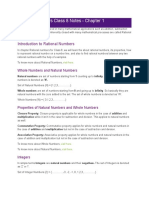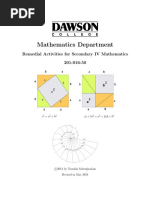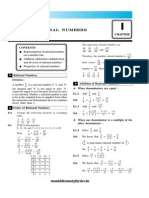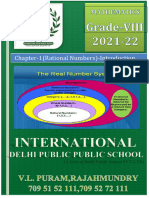Mathchapter 2
Uploaded by
gcu974Mathchapter 2
Uploaded by
gcu974Version 1.
CHAPTER
2 Rational Numbers
Animation 2.1: Rational Numbers
Source & Credit: elearn.punjab
1. Quadratic Equations eLearn.Punjab 1. Quadratic Equations eLearn.Punjab
2. Rational Numbers eLearn.Punjab 2. Rational Numbers eLearn.Punjab
Student Learning Outcomes From the above (iii) and (iv), we can notice that -2 and 6 are also
integers. But in case of division of integers, we do not always get
After studying this unit, students will be able to: the same result, i.e. are not integers. So, it means that
• Define a rational number as a number that can be expressed in the division of integers also demands another number system
the form where p and q are integers and q ≠ 0. consisting of fractions, as well as, integers that is fulfilled by the
• Represent rational numbers on number line. rational numbers.
• Add two or more rational numbers.
• Subtract a rational number from another. 2.1.1 Defining Rational Numbers
• Find additive inverse of rational numbers.
• Multiply two or more rational numbers. A number that can be expressed in the form of where p and
• Divide a rational number by a non-zero rational number. q are integers and q m 0, is called a rational number, e.g.,
• Find multiplicative inverse of a non-zero rational number. are examples of rational numbers.
• Find reciprocal of a non-zero rational number.
• Verify commutative property of rational numbers with respect to The set of rational numbers is the set whose elements are natural
addition and multiplication. numbers, negative numbers, zero and all positive and negative
• Verify associative property of rational numbers with respect to fractions.
addition and multiplication.
• Verify distributive property of rational numbers with respect to 2.1.2 Representation of Rational Numbers on Number line
multiplication over addition/ subtraction.
• Compare two rational numbers. We already know the method of constructing a number
• Arrange rational numbers in ascending or descending order. line to represent the integers. Now we use the same number line to
represent the rational numbers. For this purpose, we draw a num-
2.1 Rational Numbers ber line as given below.
In previous class, we have learnt that the difference of two
counting numbers is not always a natural number. For example,
2 - 4 = -s2 ...............(i) Now we divide each segment of the above number line into two
1 - 5 = -4 ...............(ii) equal parts, as given in the following diagram.
In (i) and (ii), we can observe that -2 and - 4 are not natural numbers.
This problem gave us the idea of integers. Now in integers, when we
multiply an integer by another integer, the result is also an integer.
For example,
-1 x 2 = -2............ (iii) In the figure 2.2, the number line represents the rational numbers
-2 x (-3) = 6............(iv) which are given below.
Version 1.1 Version 1.1
22 3
1. Quadratic Equations eLearn.Punjab 1. Quadratic Equations eLearn.Punjab
2. Rational Numbers eLearn.Punjab 2. Rational Numbers eLearn.Punjab
Now we divide further each small segment of the above drawn EXERCISE 2.1
number line into two more equal parts.
1. Write “T” for a true and “F” for a false statement.
(i) Positive numbers are rational numbers.
(ii) “0” is not a rational number.
(iii) An integer is expressed in form.
In the figure 2.3, the number line represents the following rational (iv) Negative numbers are not rational numbers.
numbers. (v) In any rational number q can be zero.
12 11 10 9 8 7 6 5 4 3 2 1 1 2 3 4 5 6 7 8 9 10 11 12
..., - , - , - , - , - , - , - , - , - , - , - , - ,0, + , + , + , + , + , + , + , + , + , + , + , + ,... 2. Represent each rational number on the number line.
4 4 4 4 4 4 4 4 4 4 4 4 4 4 4 4 4 4 4 4 4 4 4 4
Similarly, we can divide each segment of a number line into three, five -5 2 4 3
and even more equal parts and we can also represent any rational (i) (ii) (iii) 1 (iv) -2
2 3 5 4
number on a number line by using the above given method.
Example 1: Draw a number line and represent the rational 2.2 Operations on Rational Numbers
-10 In this section, we perform operation of addition, subtraction,
number
3 multiplication and division on rational numbers.
Solution:
Step 1: Draw a number line as given below. 2.2.1 Addition of Rational Numbers
(a) If and are any two rational numbers with the same
denominators, then we shall add them as given below.
-10 1
Step 2: Convert to mixed fraction -3
3 3 Example 1: Simplify the following rational numbers.
Step 3: Divide the line segment of the number line between
- 4 and -3 in three equal parts and start counting from the point -3
1 Solution:
to -4 on the first part is -3 which is our required number.
3
Version 1.1 Version 1.1
44 5
1. Quadratic Equations eLearn.Punjab 1. Quadratic Equations eLearn.Punjab
2. Rational Numbers eLearn.Punjab 2. Rational Numbers eLearn.Punjab
Solution:
(b) If and are any two rational numbers, where q , s m 0, whose
denominators are different, then we can add them by the following
formula.
(b) Consider two rational numbers with different denomina-
tors. The different is as under:
Example 2: Find the sum of the following rational numbers.
Solution:
Example 4: Simplify.
Solution:
2.2.2 Subtraction of Rational Numbers
(a) Consider tow rational numbers with the same denominators.
The difference is as under:
Example 3: Simplify the following.
Version 1.1 Version 1.1
66 7
1. Quadratic Equations eLearn.Punjab 1. Quadratic Equations eLearn.Punjab
2. Rational Numbers eLearn.Punjab 2. Rational Numbers eLearn.Punjab
2.2.3 Additive Inverse
Consider that are any two rational numbers, then
we can add them by the following method.
2.2.4 Multiplication of Rational Numbers
We can find the product of two or more rational numbers
by the given rule.
We can examine that the sum of these two rational numbers is zero. Rule: Multiply the numerator of one rational number by the
numerator of the other rational number. Similarly, multiply the
Hence, two rational numbers are called additive inverse
denominators of both rational numbers, i.e.
of each other and 0 is known as additive identity. For example,
etc. all are additive inverse of each
other.
Example 6: Find the product of the following rational numbers.
Example 5: Write the additive inverse of the following rational
numbers.
1 7 Solution:
(i) 3 (ii) - (iii)
2 4
Solution:
(i) To find the additive inverse of 3, change its sign.
Additive inverse of 3 is -3
Check: 3 + (-3) = 3 - 3 = 0 2.2.5 Multiplicative Inverse
1
(ii) To find the additive inverse of - change its sign. Consider two rational numbers where p m 0 and
2
q m 0. We find their product by the following formula as under
We can notice that the product of these two rational numbers is 1.
Hence, two rational numbers are known as multiplicative
(iii) To find the additive inverse of change its sign. inverse of each other and 1 is called the multiplicative identity.
1
For example, 2 and , -5 and etc. all are multiplicative
2
inverse of each other.
Version 1.1 Version 1.1
88 9
1. Quadratic Equations eLearn.Punjab 1. Quadratic Equations eLearn.Punjab
2. Rational Numbers eLearn.Punjab 2. Rational Numbers eLearn.Punjab
Example 7: Find the multiplicative inverse of the following rational Step 2: Multiply it by the dividend, according to the rule of
numbers. multiplication, i.e.
(i) -4
Solution:
(i) -4 Example 8: Simplify:
To find the multiplicative inverse of -4 , write the numerator as
denominator and denominator as numerator.
Multiplicative inverse of -4 is
Solution:
2.2.7 Finding Reciprocal of a Rational Number
• For any non-zero rational number the rational number is Consider a non-zero rational number which is made up of
called its reciprocal. two integers 3, as numerator and 7 as denominator. If we interchange
• The number 0 has no reciprocal. the integers in numerator and denominator, we get another rational
• The multiplicative inverse of a non-zero rational number is its number In general for any non-zero rational number we have
reciprocal. another non-zero rational number This number is called the
reciprocal of The number is the reciprocal of Likewise,
2.2.6 Division of Rational Numbers is the reciprocal of and is the reciprocal of
We know that division is an inverse operation of multiplication.
So, we can do the process of division in the following steps. We observe from here that if is the reciprocal of then is the
Step 1: Find the multiplicative inverse of divisor. reciprocal of In other words, and are reciprocals of each other.
Version 1.1 Version 1.1
10
10 11
1. Quadratic Equations eLearn.Punjab 1. Quadratic Equations eLearn.Punjab
2. Rational Numbers eLearn.Punjab 2. Rational Numbers eLearn.Punjab
EXERCISE 2.2 2.2.8 Commutative Property
1. Find the additive inverse and multiplicative inverse of the • Commutative Property of Rational Numbers w.r.t Addition
following rational numbers. Consider that and are any two rational numbers, then
(i) -7 (ii) 23 (iii) -11 according to the commutative property of addition, we have:
(vi) 6 (vii) 1
Example 1: Prove that
Solution:
2. Simplify the following.
• Commutative Property of Rational Numbers w.r.t
Multiplication
According to commutative property of multiplication, for any
3. Simplify: two rational numbers and we have:
Example 2: Prove that
Solution:
• Properties of Rational Numbers
The rational numbers also obey commutative, associative and
distributive properties like whole numbers, fractions, integers, etc. Result: Commutative property with respect to addition and
Let us verify it with examples. multiplication holds true for rational numbers.
Version 1.1 Version 1.1
12
12 13
1. Quadratic Equations eLearn.Punjab 1. Quadratic Equations eLearn.Punjab
2. Rational Numbers eLearn.Punjab 2. Rational Numbers eLearn.Punjab
2.2.9 Associative Property
• Associative Property of Rational Numbers w.r.t Addition
Consider that and are three rational numbers, then
according to the associative property of addition, we have:
Result: Associative property with respect to addition and
multiplication holds true for rational numbers.
Example 3: Prove that
2.2.10 Distributive Property of Multiplication over
Addition and Subtraction
Now again consider the three rational numbers and
Solution:
then according to the distributive property:
Example 5: Prove that
Solution:
• Associative Property of Rational Numbers w.r.t Multiplication
According to associative property of multiplication, for any
three rational numbers and we have:
Example 4: Prove that
Solution:
Version 1.1 Version 1.1
14
14 15
1. Quadratic Equations eLearn.Punjab 1. Quadratic Equations eLearn.Punjab
2. Rational Numbers eLearn.Punjab 2. Rational Numbers eLearn.Punjab
• Case II: Different Denominators
Example 7: Put the correct sign > or < between the following
pairs of rational numbers.
Solution:
Write other two rational numbers from the given rational numbers
2.3.11 Comparison of Rational Numbers such that their denominators must be equal.
We have studied the comparison of integers and fractions in
our previous class. Similarly, we can compare the rational numbers
by using the same rules for comparison. We shall make it clear with Now compare the numerators of rational numbers with the same
examples. denominators.
• Case I: Same Denominators
Example 6: Compare the following pairs of rational numbers.
By making their denominators equal
Solution:
Now compare the numerators of rational numbers with the same
denominators.
Version 1.1 Version 1.1
16
16 17
1. Quadratic Equations eLearn.Punjab 1. Quadratic Equations eLearn.Punjab
2. Rational Numbers eLearn.Punjab 2. Rational Numbers eLearn.Punjab
2.3.12 Arranging Rational Numbers in Orders Step 3: Compare the numerators 3, 8 and 1 and rearrange the
rational numbers in ascending order.
We can also arrange the given rational numbers in ascending 1<3<8
order (lowest to highest) and in descending order (highest to lowest)
in the following steps.
Step 1: Find the L.C.M of the denominators of given rational numbers.
Step 2: Rewrite the rational numbers with a common denominator. Thus, arranging in ascending order, we get
Step 3: Compare the numerators and arrange the rational numbers
in ascending or descending order. EXERCISE 2.3
Example 8: Arrange the rational numbers in 1. Put the correct sign > , < or = between the following pairs of rational
descending order. numbers.
Solution:
Step 1: The L.C.M of denominators 2, 3 and 8 is 24.
Step 2: Rewrite the rational numbers with a common denominator
as,
Step 3: Compare the numerators 12, 16 and 21 and rearrange the 2. Arrange the following rational numbers in descending order.
rational numbers in descending order.
21 > 16 > 12
3. Arrange the following rational numbers in ascending order.
Thus, arranging in descending order, we get 4. Prove that:
Example 9: Arrange the rational numbers in
ascending order.
Solution:
Step 1: The L.C.M of denominators 4, 3 and 12 is 12.
Step 2: Rewrite the rational numbers with a common denominator
as,
Version 1.1 Version 1.1
18
18 19
1. Quadratic Equations eLearn.Punjab 1. Quadratic Equations eLearn.Punjab
2. Rational Numbers eLearn.Punjab 2. Rational Numbers eLearn.Punjab
Review EXERCISE 2 5. Find the additive and multiplicative inverse of the following
rational numbers.
1. Answer the following questions. (i) -14
(i) Define a rational number.
(ii) Write the additive inverse of the rational numbers “a”. 6. Put the correct sign > or < between the following pairs of
(iii) What is the reciprocal of the rational number q m 0? rational numbers.
(iv) Write the sum of two rational numbers and q,
r m 0?
(v) What is the rule to find the product of two rational
numbers? 7. Solve the following.
(vi) What are the inverse operations of addition and
multiplication?
2. Fill in the blanks.
(i) The________ consists of fractions as well as integers.
(ii) The rational numbers and are called____ inverse of 8. Simplify the following.
each other.
(iii) A number that can be expressed in the form of where
p and q are integers and q m? 0 is called the________
number.
(iv) 0 is called additive identity whereas 1 is called ________
identity. 9. Prove that:
(v) The rational number 0 has no ________ .
(vi) The ________ inverse of a rational number is its reciprocal.
3. Tick (p) the correct answer.
Summary
4. Draw the number lines and represent the following rational • Every integer can be divided by another non-zero integer, the
numbers. number obtained is called a rational number and is written
symbolically as .
Version 1.1 Version 1.1
20
20 21
1. Quadratic Equations eLearn.Punjab
2. Rational Numbers eLearn.Punjab
• Addition of rational numbers with:
Same denominators. Different denominators.
• Subtraction of rational numbers with:
Same denominators. Different denominators.
• To find the product of two rational numbers, multiply the
numerator of one rational number by the numerator of the other.
Similarly, multiply the denominators.
• Division is an inverse operation of multiplication. So, for any two
rational numbers.
• 0 is called additive identity and 1 is called multiplicative identity.
• is called the reciprocal of
• If are two rational numbers, then according to the
commutative property:
• If and are three rational numbers, then according to the
associative property.
• Now again consider the three rational numbers and
then according to the distributive property:
Version 1.1
22
22
You might also like
- Disha - A Guide To Mathematics For NTSE - Rajat Jain82% (11)Disha - A Guide To Mathematics For NTSE - Rajat Jain385 pages
- Demo 30 Foundation Mathematics Class 8 For IIT - Disha ExpertsNo ratings yetDemo 30 Foundation Mathematics Class 8 For IIT - Disha Experts30 pages
- Grade 7 - Rational Numbers (Support Material)No ratings yetGrade 7 - Rational Numbers (Support Material)5 pages
- Rational Numbers Rational Numbers Rational Numbers Rational Numbers Rational Numbers100% (1)Rational Numbers Rational Numbers Rational Numbers Rational Numbers Rational Numbers32 pages
- Foundation Mathematics Class 8 For IIT - Disha Experts0% (1)Foundation Mathematics Class 8 For IIT - Disha Experts372 pages
- Mathematics Gist - Rational Number CLASS VII-2No ratings yetMathematics Gist - Rational Number CLASS VII-24 pages
- Grade-07 Mathematics Chapter09 Rational-NumbersNo ratings yetGrade-07 Mathematics Chapter09 Rational-Numbers14 pages
- NCERT Exemplar Problems Maths 8th Class PDFNo ratings yetNCERT Exemplar Problems Maths 8th Class PDF482 pages
- Class 8th Maths NCERT Exemplar (Combine)No ratings yetClass 8th Maths NCERT Exemplar (Combine)202 pages
- NCERT-Books-for-class 7-Maths-Exemplar-Chapter 8No ratings yetNCERT-Books-for-class 7-Maths-Exemplar-Chapter 827 pages
- Rational Numbers Class 8 Notes Chapter 1No ratings yetRational Numbers Class 8 Notes Chapter 16 pages
- Ncert Solutions Class 8 Math Chapter 1 Rational NumbersNo ratings yetNcert Solutions Class 8 Math Chapter 1 Rational Numbers18 pages
- NCERT Exemplar Problems From Class 8 Mathematics Unit 1 Rational NumbersNo ratings yetNCERT Exemplar Problems From Class 8 Mathematics Unit 1 Rational Numbers32 pages
- L#1 BM (Rational and Irrational Numbers and Their Properties)No ratings yetL#1 BM (Rational and Irrational Numbers and Their Properties)27 pages
- Rational Numbers: ©ncert Not To Be RepublishedNo ratings yetRational Numbers: ©ncert Not To Be Republished20 pages
- Introduction To Rational Numbers: Whole Numbers and Natural NumbersNo ratings yetIntroduction To Rational Numbers: Whole Numbers and Natural Numbers5 pages
- Class_8_Mathematics_Notes_for_Session_2023_24_Chapter_1_RationalNo ratings yetClass_8_Mathematics_Notes_for_Session_2023_24_Chapter_1_Rational25 pages
- Chapter-1 (Rational Numbers) - Introduction NotesNo ratings yetChapter-1 (Rational Numbers) - Introduction Notes9 pages
- Let's Practise: Maths Workbook Coursebook 8From EverandLet's Practise: Maths Workbook Coursebook 8No ratings yet
- Let's Practise: Maths Workbook Coursebook 7From EverandLet's Practise: Maths Workbook Coursebook 7No ratings yet
- Reflexes: Spinal Reflex Cranial Reflex Somatic Reflex Autonomic (Visceral) ReflexNo ratings yetReflexes: Spinal Reflex Cranial Reflex Somatic Reflex Autonomic (Visceral) Reflex4 pages
- IMPORTANT TOPICS - SCIENCE Class 10th (PRASHANT KIRAD) - Class - 10th - Most - Important - Topics (Prashant - Kirad)No ratings yetIMPORTANT TOPICS - SCIENCE Class 10th (PRASHANT KIRAD) - Class - 10th - Most - Important - Topics (Prashant - Kirad)5 pages
- Habitat The Place Where A Plant or Any Living Thing Lives Naturally AdaptationNo ratings yetHabitat The Place Where A Plant or Any Living Thing Lives Naturally Adaptation6 pages
- Finasteride and Dutasteride For The Treatment of Male Androgenetic Alopecia A Review of Efficacy and Reproductive Adverse EffectsNo ratings yetFinasteride and Dutasteride For The Treatment of Male Androgenetic Alopecia A Review of Efficacy and Reproductive Adverse Effects19 pages
- BADENAS y AURELL, 2004 - Sea Level Changes, JabaloyasNo ratings yetBADENAS y AURELL, 2004 - Sea Level Changes, Jabaloyas17 pages
- Murat Khairzhan-Uli Munkin Current Position: Mmunkin@usf - EduNo ratings yetMurat Khairzhan-Uli Munkin Current Position: Mmunkin@usf - Edu5 pages
- Lectures 1 - 10 Introduction To Classical Mechanics: Prof. N. Harnew University of Oxford MT 2016No ratings yetLectures 1 - 10 Introduction To Classical Mechanics: Prof. N. Harnew University of Oxford MT 2016102 pages
- Tensioning Issues On Chevrolet/Daewoo 16V Petrol EnginesNo ratings yetTensioning Issues On Chevrolet/Daewoo 16V Petrol Engines4 pages
- Search Warrant in Lehi City InvestigationNo ratings yetSearch Warrant in Lehi City Investigation8 pages
- Learn: Half Yearly Examination (2013 - 2014) Class Ix Foundation of Information Technology Time: 3 Hrs. M.M.: 90No ratings yetLearn: Half Yearly Examination (2013 - 2014) Class Ix Foundation of Information Technology Time: 3 Hrs. M.M.: 9023 pages
- Marine Pumps: Grundfos Industrial Solutions Marine100% (1)Marine Pumps: Grundfos Industrial Solutions Marine7 pages
- UNIT 3 - Information Technology System Applicable in Nursing Practice100% (3)UNIT 3 - Information Technology System Applicable in Nursing Practice85 pages
- Solved If The Cubic Total Cost Function Described in The TextNo ratings yetSolved If The Cubic Total Cost Function Described in The Text1 page
- Disha - A Guide To Mathematics For NTSE - Rajat JainDisha - A Guide To Mathematics For NTSE - Rajat Jain
- Demo 30 Foundation Mathematics Class 8 For IIT - Disha ExpertsDemo 30 Foundation Mathematics Class 8 For IIT - Disha Experts
- Rational Numbers Rational Numbers Rational Numbers Rational Numbers Rational NumbersRational Numbers Rational Numbers Rational Numbers Rational Numbers Rational Numbers
- Foundation Mathematics Class 8 For IIT - Disha ExpertsFoundation Mathematics Class 8 For IIT - Disha Experts
- Ncert Solutions Class 8 Math Chapter 1 Rational NumbersNcert Solutions Class 8 Math Chapter 1 Rational Numbers
- NCERT Exemplar Problems From Class 8 Mathematics Unit 1 Rational NumbersNCERT Exemplar Problems From Class 8 Mathematics Unit 1 Rational Numbers
- L#1 BM (Rational and Irrational Numbers and Their Properties)L#1 BM (Rational and Irrational Numbers and Their Properties)
- Introduction To Rational Numbers: Whole Numbers and Natural NumbersIntroduction To Rational Numbers: Whole Numbers and Natural Numbers
- Class_8_Mathematics_Notes_for_Session_2023_24_Chapter_1_RationalClass_8_Mathematics_Notes_for_Session_2023_24_Chapter_1_Rational
- Reflexes: Spinal Reflex Cranial Reflex Somatic Reflex Autonomic (Visceral) ReflexReflexes: Spinal Reflex Cranial Reflex Somatic Reflex Autonomic (Visceral) Reflex
- IMPORTANT TOPICS - SCIENCE Class 10th (PRASHANT KIRAD) - Class - 10th - Most - Important - Topics (Prashant - Kirad)IMPORTANT TOPICS - SCIENCE Class 10th (PRASHANT KIRAD) - Class - 10th - Most - Important - Topics (Prashant - Kirad)
- Habitat The Place Where A Plant or Any Living Thing Lives Naturally AdaptationHabitat The Place Where A Plant or Any Living Thing Lives Naturally Adaptation
- Finasteride and Dutasteride For The Treatment of Male Androgenetic Alopecia A Review of Efficacy and Reproductive Adverse EffectsFinasteride and Dutasteride For The Treatment of Male Androgenetic Alopecia A Review of Efficacy and Reproductive Adverse Effects
- BADENAS y AURELL, 2004 - Sea Level Changes, JabaloyasBADENAS y AURELL, 2004 - Sea Level Changes, Jabaloyas
- Murat Khairzhan-Uli Munkin Current Position: Mmunkin@usf - EduMurat Khairzhan-Uli Munkin Current Position: Mmunkin@usf - Edu
- Lectures 1 - 10 Introduction To Classical Mechanics: Prof. N. Harnew University of Oxford MT 2016Lectures 1 - 10 Introduction To Classical Mechanics: Prof. N. Harnew University of Oxford MT 2016
- Tensioning Issues On Chevrolet/Daewoo 16V Petrol EnginesTensioning Issues On Chevrolet/Daewoo 16V Petrol Engines
- Learn: Half Yearly Examination (2013 - 2014) Class Ix Foundation of Information Technology Time: 3 Hrs. M.M.: 90Learn: Half Yearly Examination (2013 - 2014) Class Ix Foundation of Information Technology Time: 3 Hrs. M.M.: 90
- Marine Pumps: Grundfos Industrial Solutions MarineMarine Pumps: Grundfos Industrial Solutions Marine
- UNIT 3 - Information Technology System Applicable in Nursing PracticeUNIT 3 - Information Technology System Applicable in Nursing Practice
- Solved If The Cubic Total Cost Function Described in The TextSolved If The Cubic Total Cost Function Described in The Text





































































































